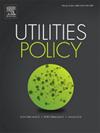定位大规模能源储存:溢出效应、碳排放和平衡意大利的成本
IF 3.8
3区 经济学
Q3 ENERGY & FUELS
引用次数: 0
摘要
实现净零需要大规模部署储能系统(LESS)。这一战略提出了关键的挑战,包括了解不同的LESS技术在经济效益和环境影响方面的比较,以及分析部署存储时市场内部和市场之间的复杂相互作用。为了帮助阐明这些方面,我们通过模拟前一天和辅助服务市场,研究了LESS位置,额定功率,持续时间和技术如何影响意大利电力系统的福利和碳排放。我们考虑了锂离子电池、抽水蓄能氢电池和钒氧化还原液流电池。结果表明,在日前市场中,部署LESS总是有利的,但由于这些市场是顺序运行的,因此辅助服务成本可能会由于溢出效应而增加。锂离子电池是最能增加社会福利的技术。地点、额定功率和持续时间显著影响碳排放,其变化范围从- 260 kgCO2到190 kgCO2每兆瓦时交易。这些结果表明,低碳可以帮助增加福利,并引发意想不到的后果,例如跨市场的溢出效应,对排放产生混合影响。本文章由计算机程序翻译,如有差异,请以英文原文为准。
Locating large-scale energy storage: spillover effects, carbon emissions, and balancing costs across Italy
Reaching net zero requires substantial large-scale energy storage systems (LESS) deployment. This strategy poses key challenges, including understanding how different LESS technologies compare in terms of both economic benefits and environmental impact, as well as analysing the complex interactions within and between markets when storage is deployed. To help shed light on these aspects, we investigate how LESS location, rated power, duration, and technology can affect welfare and carbon emissions in the Italian electricity system by modelling the day-ahead and the ancillary services markets. We considered lithium-ion batteries, pumped-storage hydro, and vanadium redox flow batteries. The results show that deploying LESS is always beneficial in the day-ahead market, but ancillary services costs can increase due to spillover effects because these markets run sequentially. Lithium-ion is the technology that yields the best social welfare increase. Location, rated power, and duration significantly impact carbon emissions, with changes ranging from −260 kgCO2 to 190 kgCO2 per MWh traded. These results suggest that LESS can help increase welfare and induce unintended consequences, such as spillovers across markets with a mixed effect on emissions.
求助全文
通过发布文献求助,成功后即可免费获取论文全文。
去求助
来源期刊

Utilities Policy
ENERGY & FUELS-ENVIRONMENTAL SCIENCES
CiteScore
6.80
自引率
10.00%
发文量
94
审稿时长
66 days
期刊介绍:
Utilities Policy is deliberately international, interdisciplinary, and intersectoral. Articles address utility trends and issues in both developed and developing economies. Authors and reviewers come from various disciplines, including economics, political science, sociology, law, finance, accounting, management, and engineering. Areas of focus include the utility and network industries providing essential electricity, natural gas, water and wastewater, solid waste, communications, broadband, postal, and public transportation services.
Utilities Policy invites submissions that apply various quantitative and qualitative methods. Contributions are welcome from both established and emerging scholars as well as accomplished practitioners. Interdisciplinary, comparative, and applied works are encouraged. Submissions to the journal should have a clear focus on governance, performance, and/or analysis of public utilities with an aim toward informing the policymaking process and providing recommendations as appropriate. Relevant topics and issues include but are not limited to industry structures and ownership, market design and dynamics, economic development, resource planning, system modeling, accounting and finance, infrastructure investment, supply and demand efficiency, strategic management and productivity, network operations and integration, supply chains, adaptation and flexibility, service-quality standards, benchmarking and metrics, benefit-cost analysis, behavior and incentives, pricing and demand response, economic and environmental regulation, regulatory performance and impact, restructuring and deregulation, and policy institutions.
 求助内容:
求助内容: 应助结果提醒方式:
应助结果提醒方式:


